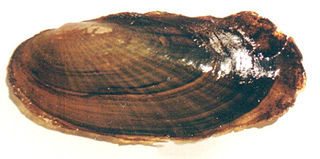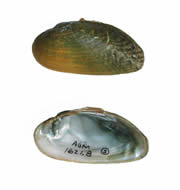
A pearl is a hard, glistening object produced within the soft tissue of a living shelled mollusk or another animal, such as fossil conulariids. Just like the shell of a mollusk, a pearl is composed of calcium carbonate in minute crystalline form, which has deposited in concentric layers. The ideal pearl is perfectly round and smooth, but many other shapes, known as baroque pearls, can occur. The finest quality of natural pearls have been highly valued as gemstones and objects of beauty for many centuries. Because of this, pearl has become a metaphor for something rare, fine, admirable and valuable.

Mussel is the common name used for members of several families of bivalve molluscs, from saltwater and freshwater habitats. These groups have in common a shell whose outline is elongated and asymmetrical compared with other edible clams, which are often more or less rounded or oval.

The Unionidae are a family of freshwater mussels, the largest in the order Unionida, the bivalve molluscs sometimes known as river mussels, or simply as unionids.

The freshwater pearl mussel is an endangered species of freshwater mussel, an aquatic bivalve mollusc in the family Margaritiferidae.

Unionida is a monophyletic order of freshwater mussels, aquatic bivalve molluscs. The order includes most of the larger freshwater mussels, including the freshwater pearl mussels. The most common families are the Unionidae and the Margaritiferidae. All have in common a larval stage that is temporarily parasitic on fish, nacreous shells, high in organic matter, that may crack upon drying out, and siphons too short to permit the animal to live deeply buried in sediment.

Anodontoides is a genus of freshwater mussels, an aquatic bivalve mollusk in the family Unionidae, the river mussels.
Potamilus metnecktayi, the Salina mucket, is a species of freshwater mussel, an aquatic bivalve mollusc in the family Unionidae, the river mussels.

Lampsilis abrupta, the pink mucket or pink mucket pearly mussel, is a species of freshwater mussel, an aquatic bivalve mollusk in the family Unionidae, the river mussels. This species is endemic to the United States.

Lampsilis is a genus of freshwater mussels, aquatic bivalve mollusks in the family Unionidae, the river mussels. There are over 100 species in the genus.

Potamilus leptodon, the scaleshell mussel or scale shell, is a species of freshwater mussel in the family Unionidae, the river mussels. This aquatic bivalve mollusk has disappeared from much of its historical range. It is endemic to the United States, where it is now present in four or fewer states; it is only found with any regularity in Missouri. It is a federally listed endangered species of the United States.

Medionidus parvulus, the Coosa moccasinshell, is a rare species of freshwater mussel in the family Unionidae, the river mussels. This aquatic bivalve mollusk is native to Georgia and Tennessee in the United States, and has been extirpated from the state of Alabama. It is a federally listed endangered species of the United States.

Obovaria retusa is a rare species of freshwater mussel in the family Unionidae, the river mussels. Its common names include golf stick pearly mussel and ring pink.

Potamilus alatus, the pink heelsplitter, is a species of freshwater mussel, an aquatic bivalve mollusk in the family Unionidae, commonly known as the river mussels.

Potamilus is a genus of freshwater mussels, aquatic bivalve mollusks in the family Unionidae, the river mussels.
Potamilus amphichaenus, the Texas heelsplitter, is a species of freshwater mussel, an aquatic bivalve mollusk in the family Unionidae, the river mussels. Freshwater Drum were confirmed as the host fish species for the glochidia reproductive stage of the Texas Heelsplitter.

Potamilus capax, the fat pocketbook pearly mussel or fat pocketbook, is a species of freshwater mussel, an aquatic bivalve mollusk in the family Unionidae, the river mussels.
The phrase Alabama heelsplitter has been used as a common name for two different species of American river mussels, freshwater bivalves, both of which can be found in Alabama. The two species are:
Lasmigona alabamensis, common name Alabama heelsplitter, is a species of freshwater mussel, an aquatic bivalve mollusk in the family Unionidae.

Potamilus fragilis, previously Leptodea fragilis, the fragile papershell, is a species of freshwater mussel, an aquatic bivalve mollusk in the family Unionidae, the river mussels. P. fragilis is one of the fastest-growing unionid species and the most abundant unionid species in Lake Erie. Its light-shelled morphology suggests an adaptation to deep water within lakes.

Ambleminae is a subfamily of freshwater mussel in the family Unionidae. They are found throughout much of eastern North America south to Central America, although fossils are also known from Siberia. Some species have also been introduced to East Asia. They are the most speciose radiation of the Unionidae, with more than 300 species.














